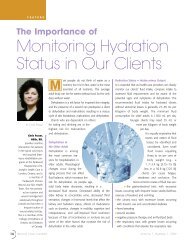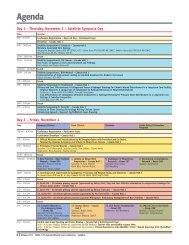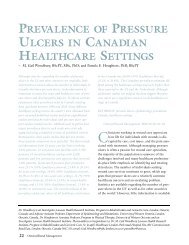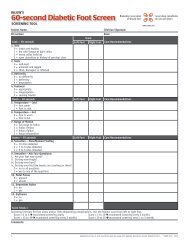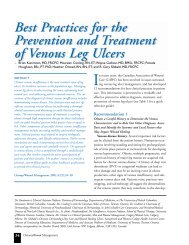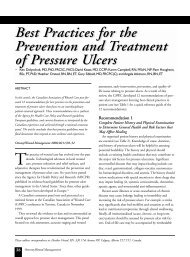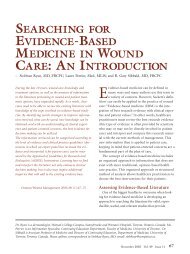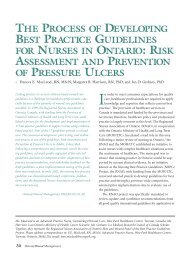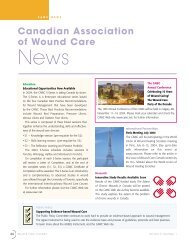Bilateral Lower Limb Lymphedema Secondary to Morbid Obesity
Bilateral Lower Limb Lymphedema Secondary to Morbid Obesity
Bilateral Lower Limb Lymphedema Secondary to Morbid Obesity
You also want an ePaper? Increase the reach of your titles
YUMPU automatically turns print PDFs into web optimized ePapers that Google loves.
as obesity rates around the world rise. These increased<br />
obesity rates have been attributed <strong>to</strong> fac<strong>to</strong>rs such as<br />
decreased activity and an abundance of inexpensive,<br />
calorie-dense food.<br />
Regardless of the cause, early diagnosis and treatment<br />
are crucial for the prevention of late-stage disease (Table<br />
1). 3,4 Education brings the hope of earlier diagnosis and<br />
treatment of patients. This is paramount, as late-stage<br />
lymphedema can be very difficult <strong>to</strong> manage and has<br />
a profound negative impact on patient well-being.<br />
The Need for Education<br />
Helping patients with BLLL due <strong>to</strong> morbid obesity is a<br />
challenge that must be addressed by wound care practitioners.<br />
BLLL patients often have complicated his<strong>to</strong>ries<br />
and complex problems. The link between obesity and<br />
BLLL has not been well described in the literature.<br />
Some theories postulate that the sheer volume of<br />
fluid found in the morbidly obese state overwhelms<br />
the lymphatic system, causing increased fluid volumes<br />
in tissues. 4 Both the low overall activity that is common<br />
in morbidly obese patients and gait changes that decrease<br />
the efficacy of the calf muscle pump cause fluids <strong>to</strong><br />
stagnate in extracellular tissues, leading <strong>to</strong> a chronic<br />
inflamma<strong>to</strong>ry state and fibrosis. 3 It is also assumed that<br />
morbid obesity itself may cause an inflamma<strong>to</strong>ry state<br />
that damages the delicate lymphatic system. 5<br />
Patients with BLLL can present <strong>to</strong> the wound care<br />
practitioner with either a his<strong>to</strong>ry of varied treatments or<br />
a complete lack of treatment. Some patients will have<br />
been <strong>to</strong>ld that nothing can be done <strong>to</strong> help them.<br />
Others may have been <strong>to</strong>ld that surgery is an option;<br />
however, simple debulking surgeries may injure or<br />
remove the delicate lymphatic vessels remaining in the<br />
patient’s tissues. 6 Some patients may be taking diuretics<br />
<strong>to</strong> treat their lymphedema. Unfortunately, diuretics<br />
may exacerbate the negative symp<strong>to</strong>ms of lymphedema<br />
by increasing the osmolarity of the lymph fluid.<br />
Indeed, diuretics can draw excessive lymph fluid away,<br />
leaving behind proteins that then become concentrated.<br />
The concentration of these osmotically active molecules<br />
only serves <strong>to</strong> draw more fluid out of the circula<strong>to</strong>ry<br />
system <strong>to</strong> equilibrate pressures in the tissues, thus<br />
perpetuating the problem. 6 Many patients are not<br />
aware that morbid obesity can cause lymphedema and<br />
that weight reduction may improve their symp<strong>to</strong>ms.<br />
Patients suffering from BLLL are particularly difficult <strong>to</strong><br />
treat due <strong>to</strong> the complexity of their medical conditions.<br />
TABLE 1<br />
The International Society of Lymphology<br />
Staging for <strong>Lymphedema</strong> 4<br />
Stage Description<br />
Stage 1 Mild pitting edema, at which point lymphedema is reversible<br />
Stage 2 Pitting is often absent and fibrotic changes are noticeable<br />
Stage 3 Characterized by elephantiasis<br />
<strong>Morbid</strong>ly obese patients often present with comorbidities<br />
such as type 2 diabetes, hypertension, hyperlipidemia,<br />
coronary artery disease and osteoarthritis. Social<br />
fac<strong>to</strong>rs related <strong>to</strong> morbid obesity, such as higher rates<br />
of depression, lower income and decreased mobility, 3,7<br />
can also complicate treatment.<br />
With the dramatic increase in morbid obesity in<br />
Canada and around the world, 7 it is highly likely that the<br />
wound care community will see many more cases of<br />
BLLL. It is therefore now more important than ever that<br />
the wound care community understands BLLL.<br />
Barriers <strong>to</strong> Optimal Care<br />
Ideal wound care for these patients should focus<br />
on shifting fluid from the limbs. The corners<strong>to</strong>ne<br />
of treatment, as described by the European Wound<br />
Management Association and the National<br />
<strong>Lymphedema</strong> Network (Table 2), is multilayer compression<br />
bandages, with an intensive initial course of<br />
manual lymph drainage by a qualified therapist.<br />
Maintaining excellent skin hygiene and exercise therapy<br />
are also important <strong>to</strong> prevent further deterioration.<br />
The treatment regimen suggested in Table 2 is<br />
comprehensive and requires a great deal of patient<br />
“buy-in” <strong>to</strong> be successful. Treatment regimens can also<br />
be difficult <strong>to</strong> follow if patients do not fully understand<br />
their benefits. These regimens require patients <strong>to</strong><br />
devote a great deal of time <strong>to</strong> their condition. Home<br />
visits by nurses usually occur three times a week for<br />
bandage application, and patients must also visit other<br />
healthcare professionals. Bandages can be itchy and<br />
uncomfortable and frequent trips <strong>to</strong> see therapists can<br />
be taxing and expensive. In addition, finding manual<br />
drainage help for patients with BLLL can be difficult and<br />
the costs are often prohibitive. A great deal of patient<br />
education is needed in order <strong>to</strong> achieve patient buy-in<br />
<strong>to</strong> such a laborious treatment plan. 8<br />
continued on page 12<br />
Volume 8, Number 2, 2010 Wound Care Canada<br />
9



